Long Range International's Long Range Hunting Course Review
If the instructors had told me before Long Range International's Long Range Hunting course (LRI's LRHC) that I would consider 600 yard shots easy, I would not have believed them. Such shots are reserved for serious long range competitors with specialized gear. The myth is that long range shooting is a complicated discipline requiring years of dedicated experience and thousands of rounds of practice. Though it is difficult, the staff instructors at LRI work hard to get the students on target at long range.
The Long Range Hunting course is intended to be an introduction to long range shooting. The students will learn how to operate their gear, shoot their rifles at long range, become proficient in night shooting, and gain skill as spotters. Additionally, an optional "mission" with Sniper/Scouts will introduce the basics of patrolling and sniping--a little taste of the USMC Sniper/Scout program. The course is designed to shoot to the maximum range of the equipment you have.
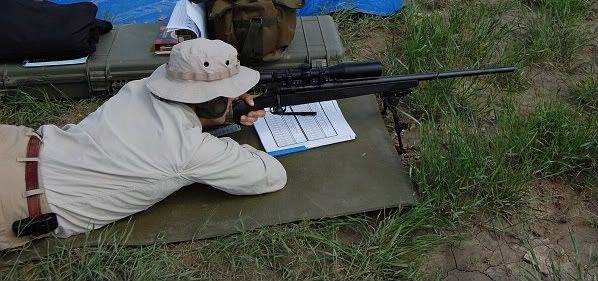
Author shooting a Savage 10FP with Pride-Fowler Rapid Reticle RR800-1 Scope
The company is owned and operated by Billy "Shep" Shepperson. He was a Sniper/Scout in the United States Marine Corps deployed to Iraq. Assisting him were several platoon members and support staff. All the shooting instructors were "8541", which is the USMC occupational specialty number for Sniper/Scout. Each instructor was deployed for at least one tour in Iraq and operated in the most extreme environment: battle in Fallujah and other locations. They have "seen the elephant" and accounted for many of our nation's enemies. Assisting them in support were Mike Hill and Larry Sloan. Larry (USMC Retired) was responsible for the meals and he cooks an excellent pot of stew. Mike Hill, a sniper from the Vietnam conflict, assisted us in organizing our gear and kept everyone in line. All the staff members worked hard to make everything run smoothly.
The LRI range is on the Shepperson ranch in Lance Creek, Wyoming. They have more than 50,000 acres, which was plenty of space for us to shoot. Two ranges were used. The first is a 100 yard range that we used for zeroing our rifles and the night shoots. The other range goes out to at least 1,000 yards and overlooks an extensive prairie dog town. It was open territory and livestock would periodically invade the range. These were a welcome break, since the days were long and Wyoming weather was as varied as it was merciless.
My rifle and scope combination were nothing expensive. I purchased a Savage 10FP rifle in 308 Winchester and didn't shoot it prior to the course. I mounted a Pride Fowler Rapid Reticle scope on it (
http://www.rapidreticle.com). My bipod was from Harris. I took a 15x45x60mm spotting scope by Winchester. None of this gear is top-of-line expensive stuff. However, as you will see, the gear was perfectly adequate for all tasks in the course. Consistency in shooting is the key, not the gear.
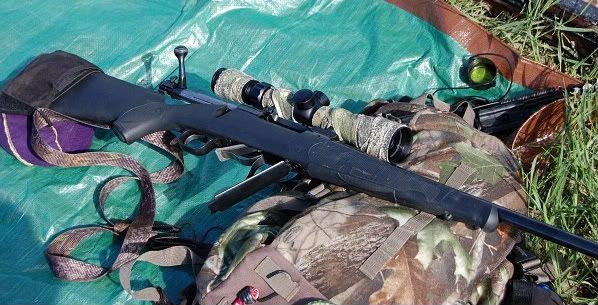
Winchester Model 70 in 30-06 that scored hits out to 1,000 yards.
Billy opened the course with a short safety briefing. The students reiterated the firearm safety rules without prompting. The ranges were "cold" ranges, since most of the shooting would be long range target shooting. Everyone paid particular attention to gun safety and I never felt uncomfortable in any way.
The first day consisted of introductory classes. These were short, one or two hour courses on a particular topic. The fundamentals of marksmanship received additional time. The course also introduced scope theory, basic ballistics, wind, spotting, and marksmanship in US history. After a long day, we were treated to a hot dinner and passed out on our racks at the school building.
The first range task assigned to us was to zero our rifles. We were divided into pairs. Everyone was using a scope, with makers ranging from a low end Millett scope to very expensive Nightforce optics. Billy did a very short safety briefing and reviewed the fundamentals of marksmanship one more time. All shooting was done from the supported prone position. Each rifle was shot using a bipod or off a pack. The stock was supported by a bean bag squeezed by the shooter's support hand. This technique provides extra support while keeping the shooter low to the ground. It resists movement caused by wind, which was a new factor for me.
About twenty rounds were allotted to zeroing. I spent thirteen rounds achieving my zero. Some students required fewer than ten rounds and others needed considerably more. The instructors assisted each student and spotted the shots as necessary. Corrections in position were made and tips passed along. Struggling students received extra attention and all managed to get solid one inch groups at 100 yards.
As the second day wore on, the distances kept increasing. By the end of the day, all teams had "dope" on ranges from 100 to 400 yards. This data was entered into our range logs and would be very important later. We carefully recorded the time, date, weather, elevation, temperature, and range conditions since each item can affect how a rifle performs. Everyone hit steel, though there were a few equipment problems. At the end of the day, we retired back to the school and had some excellent venison for dinner.
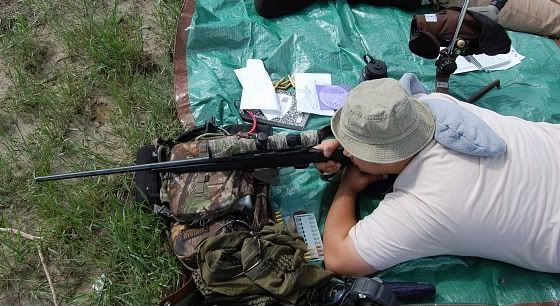
Use what you have! A student takes aim with his Winchester Model 70 in 30-06.
During the day, the instructors pushed us to the limit of our skills with team competitions. We were instructed to shoot four targets at 200 yards. We had a total of six shots and needed to do this in the shortest possible time. Shooters with semi-automatic rifles could only load three rounds per magazine and needed to do a magazine change. My first run went well, but the individual winner completed the course in just over 18 seconds. My second run was on par with the winner's first run, but his score improved. It was an excellent exercise in recoil, bolt, and ammunition management. Over the span of the course, we would see many exercises designed to develop a particular skill.
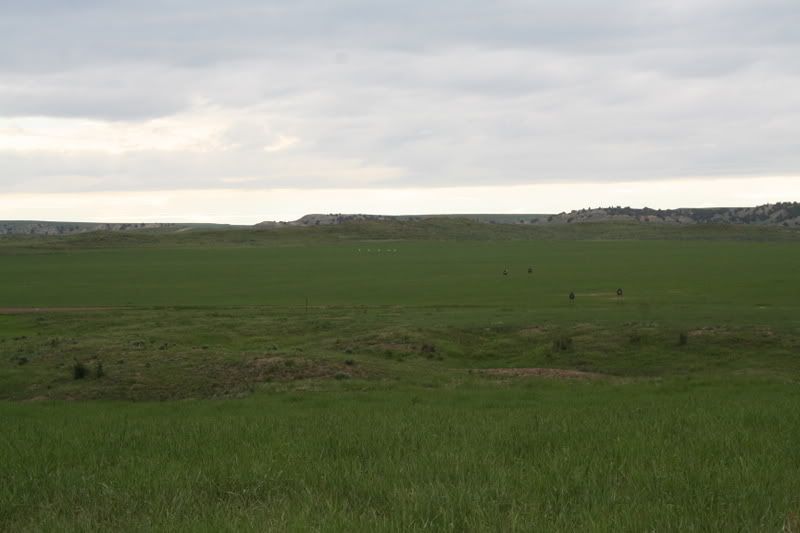
The rapid fire course and targets out at 800 yards.
The third day started out with another round of zeroing at the 100 yard range. We shot the FBI course, which consists of one cold bore shot and a four round group below it. This is very important since our first shot during a hunt will impact in a different location. The only way to mitigate this problem is to document where your rifle puts the round. It will do so consistently if the shooter does his part. Once the shooter understands how his rifle behaves with a cold bore, he can adjust his scope or hold accordingly. Additionally, we were under a time constraint for the FBI course and had only 15 seconds for all shots. I found this remarkably difficult and could only get three shots off.
The remainder of the day consisted of 500-1,000 yard shooting. Our dependence upon our partner as spotter became more important as the distance increased. Shooter and spotter communication became essential. Instructors assisted us in minimizing our verbage while maximizing our communication. The spotter's job is to talk the shooter onto the target. If the shooter disagrees with a call, then it must be discussed and a resolution agreed upon. Otherwise, the shooter just wastes ammunition. The Federal Gold Medal Match 308 Winchester ammunition that everyone was using is NOT cheap, so we worked hard to master this skill.
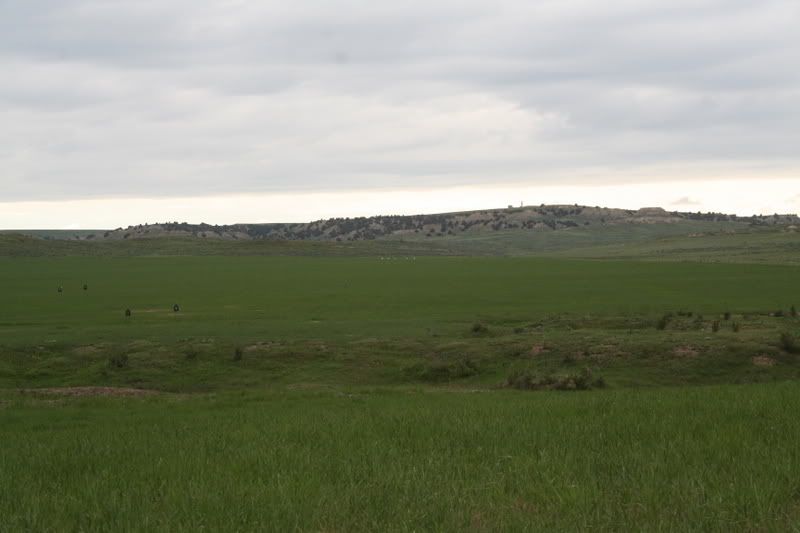
18"x24" steel targets at 1,000 yards.
Wyoming's famous wind picked up late in the day. At this point, we were shooting at targets 800 yards away. The ability of the spotter to judge wind became essential. We learned the "lingo" at our 8541's direction and I found it to be a huge advantage. The wind was strong at this range and I wasted quite a bit of ammunition. Ironically, the 900 and 1000 yard targets were considerably easier to hit when the winds died down. Everyone, from the guy with the "basic" 30-06 hunting rifle to the one sporting a Tubbs 2000 rifle, struck steel at 1,000 yards. This is yet another lesson: expensive rifles and scopes are not required to play the 1,000 yard game! Granted, we won't win competitions, but we certainly can hit a man or large animal at that range.
Day four started out with another FBI cold bore shoot and a bit extra data. Billy preached "consistency is the key" continuously and I had ignored that directive. The night before, I added another 1/2" of cheek padding to the stock of my rifle. My point of aim changed and I shot low by one MOA (approximately one inch) during the shoot. I made a minor adjustment and vowed to stay as consistent as possible. The class moved up to the long distance range and shot an "unknown distance course." This is the "meat and potatoes" of long range shooting: deer and men don't carry around signs showing the distance. Billy cranked up the pressure by giving us only ten minutes to estimate ranges and figure "dope" for our scopes. It was a team competition, with ten points for a first shot hit and eight points for a subsequent shot hit. It was deceptively difficult, but everyone hit targets at short, medium, and long range in the wind and rain.

Shooter and spotter prepare a shot.
The assault course was up next. Four steel targets were setup approximately 150-200 yards away. Our goal was to lay down suppressive fire and move out of the area. Different sorts of cover was available. The students brought a variety of weapons: hunting rifles, AK-47's, AR-15's and even an M1A. We maneuvered through the course and had a great time doing so. The lesson was clear: define your goal and execute it as quickly as possible.
After the assault course, we returned to the school for lunch and additional instruction in trip planning. Billy and the others showed us a variety of gear. We learned the basics of mission planning the USMC way. They write 70 page documents to plan a simple patrol! Obviously, a hiking or hunting trip does not require that much detail, but I certainly have no excuse for forgetting the tooth brush on my next outing.
An optional "mission" was planned for the night of the fourth day. Some armed bad guys have moved into the area and were committing crimes on the ranch! Law enforcement was unavailable for some reason, so it was time to patrol the area. Only three students elected to go on the mission, so we prepared our gear while the others took a much needed rest. We worked together to ensure all gear was properly stowed, team positions were determined, and essential gear (such as radios) was tested. At 8 PM, we began rehearsing entering and leaving our insertion vehicle. The team, along with three 8541's, began moving toward the objective at 8:30 PM.
We exited the vehicle according to plan. Our first lesson was how to maintain security and cross roads. The team assembled behind a small ridge and began navigating toward the objective. As night fell, clouds moved in and reduced visibility to only 10 yards. We moved through several fields, around ridges and draws, and navigated through fences and cactus. Prickly pear cactus spines worked their way into hands and knees. I ground my Glock's plastic rear sight down with a short low crawl under a barbed wire fence and the magazine well filled with sand.
This was no boring patrol! The enemy was active and had a jeep with a spotlight. They patrolled the road, so we prepared an ambush. Our previous encounter with an "enemy occupied" hill and a hot contact drill must have drawn their attention. We set-up an ambush along the road and waited. Flares suddenly lit the area and we "commenced firing" upon the target. Apparently, we missed because they kept going. We circled around a draw and ambushed them fifteen minutes later when they stopped to rest. Many lessons were learned in that mad rush through rocky draws.
After the elimination of the enemy patrol, we navigated our way to a large hill overlooking the objective area. We could see four enemy soldiers in the camp. Being of average IDPA target size, we could estimate the range, but a handy laser range finder determined the distance to be approximately 550 yards. By 3 AM, we had set-up our position and waited for first light. All three students took their shots at approximately 5 AM. I had dinged my scope, so my first round went low. I compensated approximately two MOA and scored a second shot hit. The second volley took out the fourth and final target. We moved to the extraction point and a much needed rest.
The remainder of the fifth day consisted of free shooting and practice. Additional pointers were given and questions answered. Several Sniper/Scounts gave their opinions on shooting, gear, and rifles. Several were gunsmiths, so there was no shortage of technical detail. We wrapped up the day with a pig roast and party.
I had time to reflect upon the busy week as Larry roasted some fresh pork loin. Prior to the course, I had considered three hundred yards to be a long and difficult shot. I had no idea how to operate my scope and had never used a vapor trail to talk a shooter on target. Wind was a mystery. Looking back on it, I can see just how effective the lessons of each day were. As the group gained confidence at one range, the pressure was slowly increased. By the end of the course, every student knew his scope and rifle--and that it could get hits at 1,000 yards. I certainly feel confident that I can repeat this process at home. In all, this experience has dramatically improved my confidence in my own shooting abilities. The shooter makes all the difference.
If you would like more information about upcoming Long Range International classes, please go to
http://www.longrangeinternational.com. Go into the "LRI Courses" forum. The courses, gear, and directions are listed there.